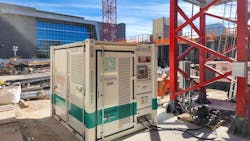Onsite Storage Powers Electric Cranes in Las Vegas
Construction of a new civic center building and plaza in downtown Las Vegas, Nevada, required heavy-lift equipment while supporting the net zero energy and carbon reduction goals of the city’s 2050 Master Plan.
Content provided by Ampd Energy
The two-block site in the heart of downtown Las Vegas is a historic area with an older power grid. Despite being in a busy urban neighborhood, the job site had limited access to power. The contractor initially considered using diesel-powered crawler cranes, which would not disrupt visibility because they are operated from the ground. But this less-efficient solution was likely to slow the project’s timeline and increase operational costs.
Crane dealer Compass Equipment and UPERIO proposed using electric tower cranes, which they said would provide superior performance to the crawler cranes. During the early stages of the project, two massive 400 kVA generators powered the two tower cranes, requiring a large footprint and consuming a lot of diesel fuel.
In addition, the crew had to improvise strategies to make the generators work hard enough to supply the required power in a reliable manner, eventually adding unnecessary electric heaters to provide artificial electrical load on the generators between lifts. Two additional 120 kVA generators would be needed to power two construction elevators also deployed at the site.
Power storage for electric tower cranes
UPERIO and Compass turned to Ampd for an alternative method of suppling power for the lift equipment. They deployed two Enertainer energy storage system (ESS) units, which were used to power all four pieces of hoist equipment. This enabled them to provide the client with a turnkey package that delivered a more reliable, economical, and sustainable power supply than the generators, according to Ampd.
Read more about mobile charging of equipment on job sites
The Ampd Enertainer is designed specifically for the needs of the construction industry. By reducing or replacing the need for generators, the unit makes construction sites quieter, safer, and more efficient while reducing or eliminating diesel-related air pollution, it says. It also has a footprint about half the size of a comparable generator.
Once the Ampd units were installed, the team was able to switch to a pair of 70 kVA supply generators, one for each ESS, dramatically reducing the site’s fuel consumption and carbon footprint. The onboard computers in the Ampd units automatically managed the capacity and run times of these generators, switching them on and off as needed to optimize battery charging and fuel consumption.
This arrangement enabled the ESS units to supply all the power needed for the tower cranes and construction elevators, which were operated for up to two shifts each working day.
